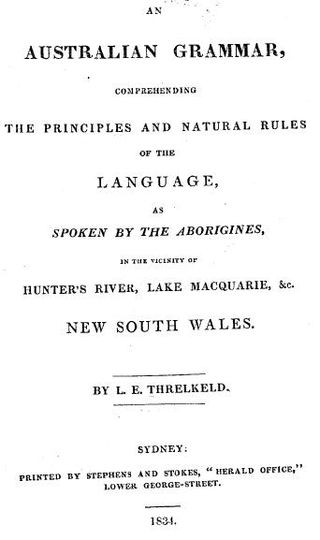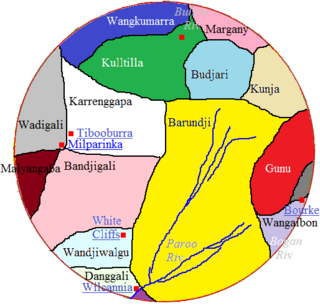
An Australian grammar : comprehending the principles and natural rules of the language, as spoken by the Aborigines in the vicinity of Hunter's River, Lake Macquarie, &c. New South Wales is a book written by Lancelot Edward Threlkeld and published in Sydney in 1834. It is a grammar of the Awabakal language.

Kuringgai is an ethnonym referring to an Indigenous Australian people occupying the territory between the southern borders of the Gamilaraay and the area around Sydney, and an historical people with its own distinctive language, located in part of that territory.

The Bundjalung people, also spelled Bunjalung, Badjalang and Bandjalang, are Aboriginal Australians who are the original custodians of a region from around Grafton in northern coastal New South Wales to Beaudesert in south-east Queensland. The region is located approximately 550 kilometres (340 mi) northeast of Sydney and 100 kilometres (62 mi) south of Brisbane that now includes the Bundjalung National Park.
The Wangaaypuwan, also known as the Wangaibon or Ngiyampaa Wangaaypuwan, are an Aboriginal Australian people who traditionally lived between Nyngan, the headwaters of Bogan Creek, and on Tigers Camp and Boggy Cowal creeks and west to Ivanhoe, New South Wales. They are a clan of the Ngiyampaa nation.
The Jarildekald people, also known as Yarilde or Yaralde, are an Aboriginal Australian people of South Australia originating on the eastern side of Lake Alexandrina and the Murray River.
The Ngarkat is a recorded title of a tribal group from South Australia. The Ngarkat lands had linked the mallee peoples of Victoria and South Australia to the river peoples of the Murray River Murraylands. Ngarkat language has been loosely grouped with Peramangk language though not by linguists, and the grouping was perhaps partly owed to the co-ownership of lands in both the Ninety Mile Desert and Echunga by John Barton Hack, and partly to the occasional meeting of tribes. The language of the Ngarkat was recorded as being Boraipur by Ryan in recent times though sources were not given, while it may yet be telling that the citing work concerns Mallee peoples to the east. The language may have been midway between that of mallee peoples to the east, and that of peoples to the west recorded by Teichelmann and Schurman. It is known that songlines linked the Coorong to the Mallee regions, hence went through Ngarkat land. It is also known that Ngarkat people did meet regularly with tribes to the east, at sites along the Murray.
The Maia were an indigenous Australian tribe of Western Australia.
The Kwiambal are an Aboriginal Australian people of New South Wales.

The Karenggapa are an Aboriginal Australian people of New South Wales.
The Wanggumara, also spelt Wangkumara, Wongkumara, Wangkumarra, and other variants, are an Aboriginal people of the state of Queensland, Australia.
The Bidjara people, also spelt Bitjara or Bithara, are an Aboriginal Australian people of south-western Queensland. They spoke a dialect of the Ngura language. They are not to be confused with the Warrego River Pitjara or the Badjiri of the Paroo River, both of whose traditional lands are further to the east of the state.
The Warrgamay people, also spelt Warakamai, are an Aboriginal Australian people of the state of Queensland.
The Koa (Guwa) are Australian Aboriginal people and Native Title Holders of land in the Upper Diamantina River catchment area in the state of Queensland that includes the towns of Winton, Kynuna, Corfield and Middleton.
The Kunggara, also known as Kuritjara, are an indigenous Australian people of the southern Cape York Peninsula in Queensland.
The Garaynbal, also written Karingbal, are an Aboriginal Australian people of the state of Queensland. They spoke a dialect of Biri called Garaynbal, now extinct.
The Jeithi were an indigenous Australian people of the state of New South Wales.
The Gawambaraay (Kawambarai) are an Aboriginal Australian people of the state of New South Wales, closely connected to the Gamilaraay (Kamilaroi) people. Their traditional lands are in the central–western district of New South Wales
The Wanjiwalku were an indigenous Australian people of the state of New South Wales.
The Wiyabal are an indigenous Australian people of the state of New South Wales.
Reverend Dr John Fraser was an Australian ethnologist, linguist, school headmaster and author of many scholarly works. He is known for his revised and expanded version of Lancelot Threlkeld's 1834 work, An Australian Grammar, with the new title An Australian language as spoken by the Awabakal, the people of Awaba or Lake Macquarie being an account of their language, traditions and customs / by L.E. Threlkeld; re-arranged, condensed and edited with an appendix by John Fraser (1892). In this, Fraser created new divisions and terminology for some Aboriginal groups in New South Wales.